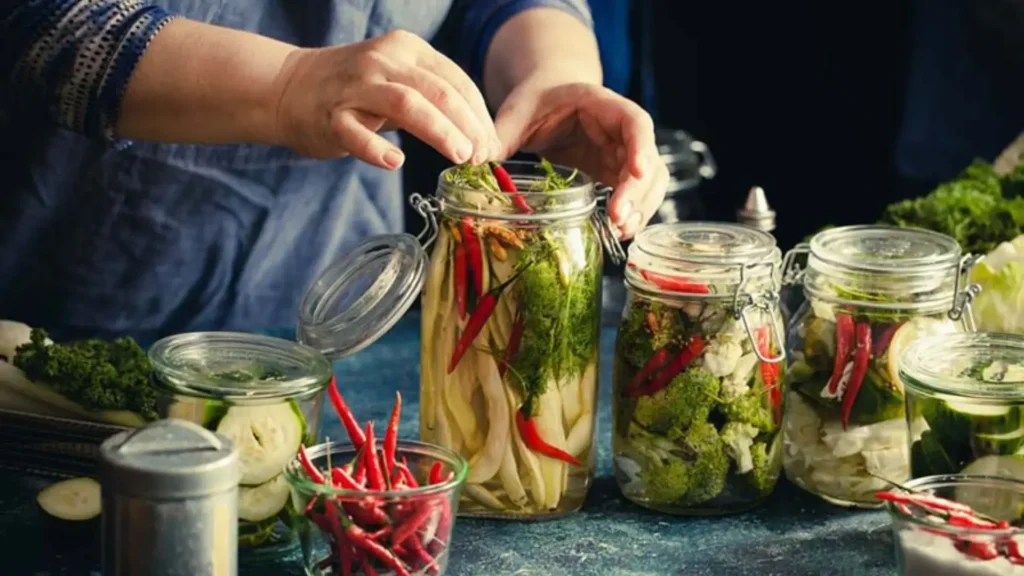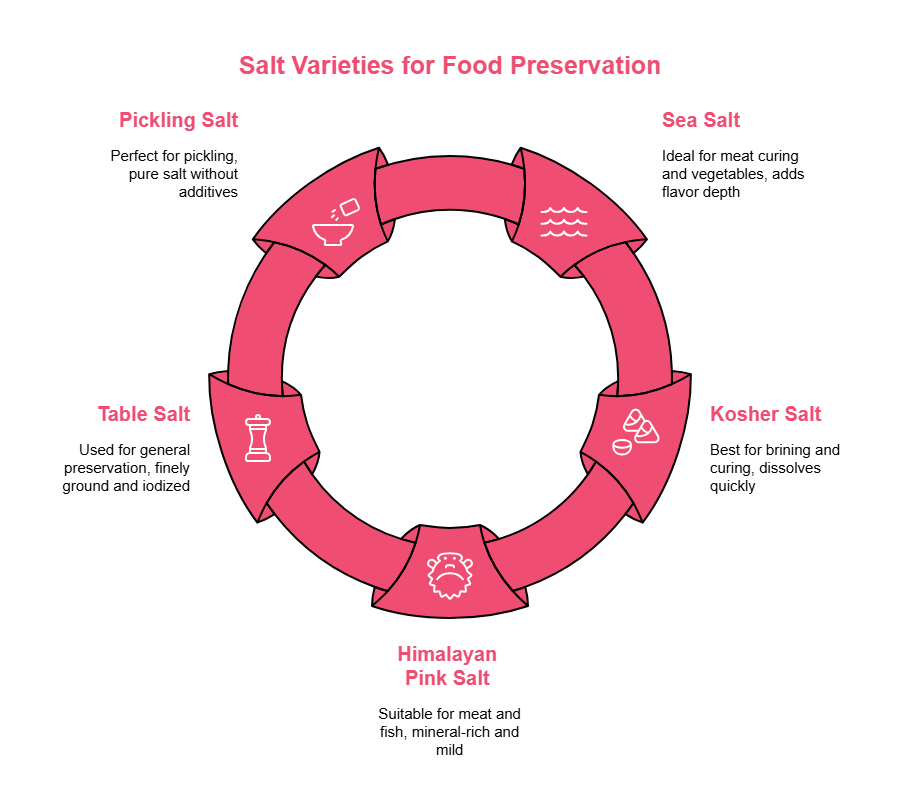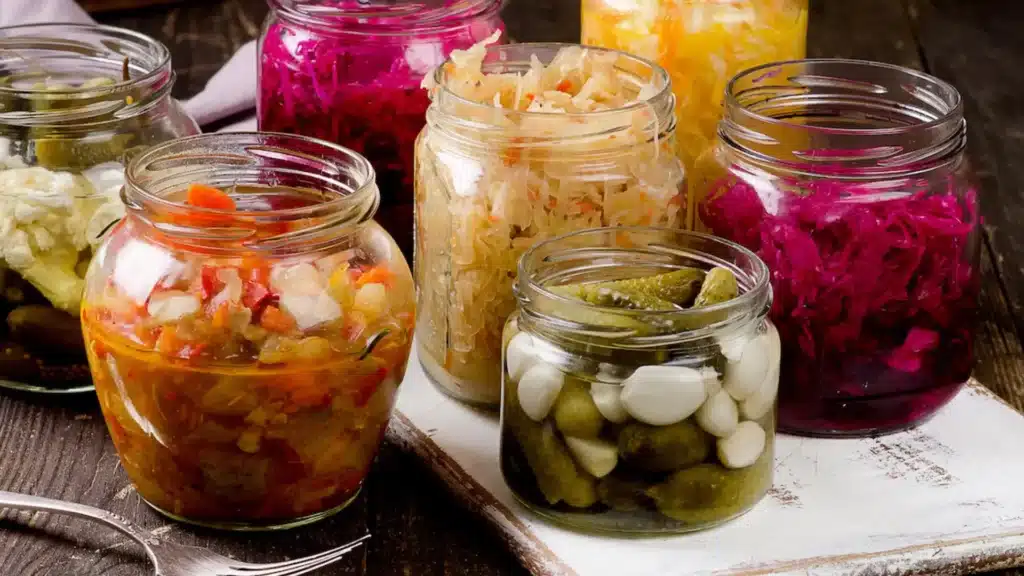
Table of Contents
Salt is one of the oldest and most reliable methods of keeping food fresh. Long before refrigerators existed, people discovered that salting food could extend its life, stop spoilage, and make it safe to store for weeks or even months. From preserving meat and fish to pickling vegetables, salt has been a trusted ally in kitchens around the world.
But how exactly does salt preserve food? What are the best methods to use it safely? And is it still relevant today when modern preservation methods are available? In this guide, we’ll explore how to use salt for food preservation, the science behind it, the different techniques, and even the surprising benefits of using salt for Food Preservation.
Why Salt Works as a Preservative

To understand how to preserve food with salt, you need to know the science. The key lies in osmosis. When salt is added to food, it draws out water from the cells. Bacteria and molds need moisture to survive and grow. By reducing water activity, salt creates an environment where harmful microbes can’t thrive.
Here’s what happens when you preserve with salt:
- Moisture removal: Less water means fewer chances for bacteria to grow.
- Microbial inhibition: Salt makes conditions too harsh for most microorganisms.
- Flavor enhancement: Beyond safety, salting food often makes it taste richer and more complex.
This is why salting food preservation has been trusted for centuries.
Read More: How to Use Himalayan Salt for Cooking
Types of Salt for Food Preservation
Not all salts are created equal. Choosing the right type of salt can improve both the safety and taste of preserved foods.
Type of Salt | Best Use | Notes |
Sea Salt | Meat curing, vegetables | Contains trace minerals, adds flavor depth. |
Kosher Salt | Brining, curing | Larger crystals, easy to handle, dissolves quickly. |
Himalayan Pink Salt | Meat, fish | Mineral-rich, mild flavor, natural look. |
Table Salt | General preservation | Finely ground, usually iodized, but additives may cloud brines. |
Pickling Salt | Pickling | Pure salt without anti-caking agents, keeps brines clear. |
Tip: For clearer brines, avoid iodized salt in pickling.
Learn about:
Understanding the Mineral Composition of Himalayan Pink Salt
How Does Salt Preserve Food? (The Science Explained)
When you’re preserving food with salt, you’re essentially creating a survival-unfriendly environment for microbes. Here’s how:
- Water activity drops – Microbes can’t multiply without water.
- Cell dehydration – Salt draws out fluids from food and bacteria alike.
- Chemical reactions slow – Enzymes that cause food spoilage become inactive in salty environments.
So, when someone asks how does salt preserve food, the short answer is: it removes water and creates an environment hostile to bacteria and spoilage.
Salting Food Preservation Techniques
There are several effective ways to use salt for food preservation. Let’s go through the most common ones:
1. Dry Salting (Dry Curing)
- Method: Rub salt directly onto food (meat, fish, or vegetables).
- Effect: Draws out moisture, leaving food dry and safe to store.
- Example: Traditional prosciutto, salted cod, or sauerkraut.
2. Brining (Wet Curing)
- Method: Submerge food in a saltwater solution.
- Effect: Preserves food while keeping it juicy and tender.
- Example: Pickles, corned beef, or brined chicken.
3. Pickling with Salt
- Method: Use salt to ferment vegetables (with or without vinegar).
- Effect: Natural probiotics develop, making food safe and tangy.
- Example: Kimchi, dill pickles, or salted lemons.
4. Salt-Packing for Fish
- Method: Layer fish in salt and leave to cure.
- Effect: Extends shelf life and intensifies flavor.
- Example: Anchovies, traditional dried fish.
Each of these methods shows the versatility of salt preservation in keeping food safe and tasty.
Balancing Health and Preservation

While salt is excellent for food preservation, one concern many people have is the sodium content. Eating too much salt can affect health, so moderation is key.
- Use only the required amount of salt to preserve food.
- Rinse preserved foods before cooking to reduce saltiness.
- Combine salting with other methods (like refrigeration) for balance.
Remember: the goal is to make food safe without making it unpalatable.
Read About: Health Benefits Of Himalayan Pink Salt
Modern Uses of Salt Preservation
Even though we now have freezers and fridges, preserving food with salt hasn’t lost relevance. In fact, it’s making a comeback for several reasons:
- Natural preservation: No chemicals, just salt.
- Flavor development: Salt curing creates unique tastes.
- Sustainability: Useful in areas with limited electricity.
This makes how to preserve food with salt not just an old tradition but a practical choice today.
Explore More: Himalayan Salt Brick Uses
Benefits of Using Salt for Food Preservation
Salt is one of the oldest and most natural methods of keeping food fresh. Long before refrigerators and freezers were invented, people relied on salt to preserve meat, fish, vegetables, and even fruits. The benefits of using salt for food preservation go far beyond just taste; it also ensures food safety, extends shelf life, and reduces waste.
1. Extends Shelf Life
One of the biggest advantages of salt is that it draws out moisture from food through a process called osmosis. Since bacteria and mold need water to grow, removing that moisture helps prevent spoilage. This means your food can stay fresh for weeks or even months without refrigeration.
2. Prevents Bacterial Growth
Salt creates an environment where harmful bacteria like Salmonella or E. coli cannot thrive. By lowering the water activity in food, salt naturally inhibits the growth of microorganisms, making your preserved food much safer to eat.
3. Enhances Flavor Naturally
Unlike chemical preservatives, salt doesn’t just protect food it also enhances its flavor. Salt-curing meat or pickling vegetables brings out a unique, rich taste that you can’t achieve with artificial preservatives. That’s why traditional recipes like salted fish, pickles, and cured meats are still popular today.
4. Reduces Food Waste
Using salt for food preservation is also an eco-friendly choice. Instead of throwing away perishable foods, you can preserve them with salt and store them for later use. This is especially useful during harvest seasons or when buying food in bulk.
5. A Cost-Effective Preservation Method
Compared to modern refrigeration or chemical preservatives, salt is inexpensive and easy to use. You don’t need any advanced equipment, just salt and proper storage containers. That’s why salt has been trusted by households and food industries for centuries.
Best Practices for Preserving Food with Salt
To get the best results when using salt for preservation, keep these tips in mind:
- Measure properly: Too little salt won’t prevent spoilage; too much may ruin taste.
- Choose the right salt: Pickling salt for clear brines, kosher salt for meat curing.
- Store correctly: Keep preserved foods in airtight jars or containers.
- Check regularly: Watch for signs of spoilage even in salted foods.
Conclusion
Salt is far more than a kitchen seasoning. It is a powerful, natural, and time-tested preservative that has kept food safe for centuries. Whether you’re salting food for preservation, brining, or pickling, this simple mineral can extend shelf life, improve taste, and connect you to culinary traditions worldwide.
If you’re looking to start preserving food naturally, choosing pure, mineral-rich salts like those from Sobaan Salts can make a noticeable difference in both taste and safety.
By understanding the benefits of using salt for Food Preservation effectively and responsibly, you can enjoy food that is safe, flavorful, and preserved in the most natural way possible.
Beyond the kitchen, the benefits of animal salt licks show that salt plays an equally important role in agriculture and livestock health.
The World Health Organization estimates that excessive sodium intake contributes to 1.89 million deaths annually due to related health issues like cardiovascular diseases, highlighting the importance of using salt judiciously in food preservation. Reducing sodium intake by using salt substitutes or combining preservation methods can help mitigate health risks while maintaining food safety. (Source: World Health Organization – Sodium Reduction)
Reference:
- NIH.gov – “Preservation and Physical Property Roles of Sodium in Foods“
- WHO.int – “Sodium Reduction”
Share This Post
Article By

